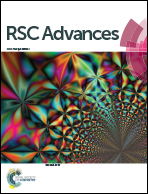Influence of a resorcin[4]arene core structure on the spatial directionality of multi-arm poly(ε-caprolactone)s†
Abstract
Highly crystalline directional polycaprolactones (PCLs) based on two tetrahydroxy methyl resorcin[4]arene initiators were synthesized by a “core first” method via ring-opening polymerization of ε-caprolactone catalyzed by Sn(Oct)2 in bulk at 120 °C. The synthesized polymers were characterized by nuclear magnetic resonance (NMR), thermogravimetric analysis (TGA), differential scanning calorimetry (DSC), and wide angle X-ray scattering (WAXS). The structures of tetra-arm PCLs based on resorcinarenes were confirmed by 1H NMR analysis. The thermal properties were evaluated using DSC and TGA. The spatial directionality, a consequence of the rigid bowl shaped resorcinarene cavitand core, of the PCL chains influenced the thermal properties and crystallinity of the polymers. The melting temperature (Tm), decomposition temperature (Td) and % crystallinity (%Xc) of the directional PCL from the rigid core cavitand 2c were significantly higher than those of the linear counterpart and the PCL from the somewhat flexible cavitand core 3c. The data implies that the spatial directionality of the polymer chains in multi-arm polymers can be used to manipulate their thermal and physical properties. Detailed analysis of the two tetra-hydroxy resorcinarene initiators and a comparison with linear PCLs is discussed.
![Graphical abstract: Influence of a resorcin[4]arene core structure on the spatial directionality of multi-arm poly(ε-caprolactone)s](/en/Image/Get?imageInfo.ImageType=GA&imageInfo.ImageIdentifier.ManuscriptID=C3RA47678B&imageInfo.ImageIdentifier.Year=2014)

 Please wait while we load your content...
Please wait while we load your content...